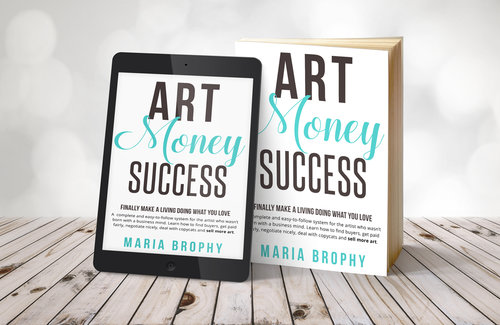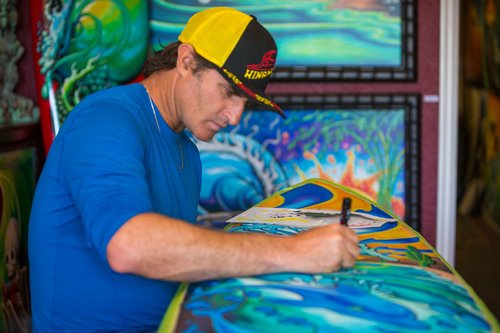by Carolyn Edlund
Don’t miss this newly-released practical guide for artists who want to market themselves more effectively.

Maria Brophy’s new book Art, Money & Success addresses many of the fears and challenges that artists face when trying to start and grow their businesses. Taking a practical approach and using a conversational tone, the author shares her best advice and insights for artists.She includes examples from her own experience managing the business side of a partnership with her well-known surf artist Drew Brophy.
Encouraging and positive, this easy-to-read book contains lots of specific strategies that artists can use. Maria and I recently talked about the topics she addresses in her book.
AS: What have you found are the biggest challenges holding artists back from success in business?
MB: Great question. I’ll try to keep it short, but there are many. The four most common challenges I see are:
The artist doesn’t know what they want. People always say, “Oh, that’s easy. I want to be successful.” But what does that look like? You must have a specific, clear understanding of what success means to you, before you can get it. Does success mean earning $80,000 a year, selling your art joyfully to collectors? That’s a specific understanding. The first chapter of ART, MONEY & SUCCESS is all about how to figure out exactly what you want. Once you know what you want, then you can work towards making it happen.
The artist doesn’t view their art business as a business. They are stuck in old school thinking that someone or something will “discover” their talent and take them to the next level. When we wait for someone to discover us, we don’t take necessary action to grow. But as soon as we realize that we are a business, not an employee, we can begin making strong decisions that will amp up our earning power.
The artist doesn’t trust or believe that they can be successful selling their art. You have to believe it first, and trust that you’ll figure it out, so that you’ll be led to powerful ideas and actions. The belief has to come before everything else. For an artist who is having trouble believing, but they want to learn how, all they have to do is look at the tens of thousands of artists who are already earning a good living with their art.
The artist isn’t focusing their time on the one most important thing they should be doing. Many artists are trying to be everything to everyone, on all social media accounts and on many different sales channels online. The problem with this is that efforts are scattered and there are very little results that come from that. It’s best to focus on growing one thing at a time, and once you master that one thing to perfection, then add another thing, and so on.

Author Maria Brophy. Photo credit: Scott Smallin
AS: You and your husband Drew have built a business using solid strategies and consistent action. What do you feel are the most important lessons you’ve learned from marketing his art?
MB: Oh, there are so many, it’s hard to choose which ones to list first! But I’ll do my best:
We set monthly and yearly financial goals and track our income daily. If we are far off from our income goal for the month, we brainstorm ways to make sales so that we hit the goal. When you have a goal, and you want to hit it, you will find a way to hit it.
We (and you) get to choose our “business model.” This means that we make all the rules for our business. We get to decide where the art will go and how we will charge and collect money from clients. No one else can tell us how to run our business. We stand firm on this, and when someone asks us to do something that isn’t in alignment with our business model, we tell them that.
For example, recently a new business opened and called for artwork on their walls. I was excited about the sale until they said “oh, we will hang it here on consignment.” I said “I appreciate your interest, but putting art on consignment in a wellness center doesn’t work with our business model. But what we can do is offer a payment plan for you to buy it.” When you tell people “that doesn’t fit with my business model,” they view you as a professional and do not question your methods.
We are constantly educating ourselves on business tactics. We’re always learning new strategies and implementing them.
We never say “we can’t” and instead, ask “how?” When you ask the right questions, the right answers will eventually come.
We’ve set up multiple streams of income so that if one is slow, the others sustain the business. We continuously brainstorm new ways to earn passive income through licensing and product sales.
We learned to stop giving art away mindlessly and instead, charge the people who were asking for donations and freebies. Instead of giving art, we give money to our three favorite charities instead. For all other charities who ask for artwork donations, we require that we set the starting bid price and that we share in the proceeds 50/50, so that we get paid from the auction as well as they do. Giving a 50% donation is incredibly generous!
Many artists don’t realize that they can ask the charity to share the proceeds with them. Sometimes a charity will say “no thanks” because they don’t want to share the proceeds with you; they want it all to themselves. That’s okay, it won’t hurt you any if they go away, it actually is good because they will take you off of their solicitation list. Don’t give art to charities who don’t value your time or your art, as it harms your business.
AS: How can artists begin to develop a network that will provide fans and collectors of their work?
MB: The best way is to get out of your little bubble and do live events and meet people in person. There are multiple ways to get your work shown at a live event, without it costing you anything, and sometimes even being paid for it. Trade shows, parties, events, festivals, there are countless opportunities to be paid to show your work. You just have to create the opportunity for yourself. You begin by asking “what type of person does my art align with?” And then, ask “what types of events or trade shows does that person attend?” Then, you create a way to show your work as a benefit to another entity that is catering to that same target market. This has worked for us again and again over the years. I cover this in detail in ART, MONEY & SUCCESS.
Once you find your target market, or your fans, or your people, then you collect their email addresses and form an intimate relationship through email marketing. It’s incredibly powerful. Last summer we did an email campaign in June and sold $20,000 in art prints in just one month! Every sale came directly from our email list.

Artist Drew Brophy in the studio. Photo credit: Larry Beard
AS: In your book, you talk about the power of saying “No.” How does this work?
MB: You cannot do it all, and you should only be doing what is leading you directly to your big goal. To reach your big goal, you have to say yes to anything that takes you closer to it, and no to everything else.
If your big goal is to earn $10,000 every month, and you are offered a chance to teach kids for a week for only $1,000, then you have to either say NO or require to be paid $2,500 (1/4 of $10K) so that it leads you to your goal. This is why having financial goals is so important, so that you make the best decisions on how to spend your time.
Another example: Your goal is to become the best known yoga-inspired artist. You are offered an opportunity to create art that is of a completely different theme and style than your own, and it will take you a month or longer. You would say no to this, as it takes you further from your goal.
And one last example: You love oil painting and do not like sketching at all, but a good friend’s wife just died and it would mean so much if you would do a black and white drawing of something important to them. Many artists would take on this job out of sympathy, only to be frustrated because they are trying to do something they are not good at and don’t enjoy, just to make someone else happy. In a sensitive case like this, you still have to say NO because by saying yes, someone else’s desires are harming your energy and ultimately your business. Instead, refer the friend to someone who is great at sketching and who will do the best job for them. Get good at saying “No, I don’t do that, but I can refer you to someone who does.”
Too many people allow themselves to be pulled away from what they want, by other people’s desires. You have to protect every minute of your day. The health and longevity of your art business depends on it.
AS: What is your best advice for an artist who wants to commit to a full-time business?
MB: For the artist who is already selling their work and has built up a collector base, even a small one, I recommend making a decision. If you want to be a full-time artist, do what it takes; make a business plan, get a small business loan if necessary, and start working on your business.
For the artist who hasn’t sold anything yet, I recommend testing out the market first. Build up a portfolio and a strong body of work. Show your work at a few festivals or events and see how well it sells. Don’t quit your day job until you put in enough time to find out if there is a market for your work.
For all artists, full time and part time, I strongly recommend taking basic business courses. The most important skills to learn are goal setting, marketing and selling. And of those three, goal setting comes first. You can’t be successful until you know exactly what you want and you have a clear picture in your mind of what success means to you.



Carolyn, thank you for featuring me on your blog. It’s an honor and I appreciate it!
My pleasure, Maria. You have excellent advice, and I know you are a favorite of many artists!
Thanks for sharing Maria’s book! It’s on my Amazon wish list and I hope to order a copy soon.
Beautiful content, sounded like a poem to me! Gratitude!